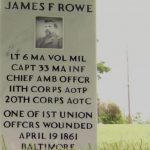Stillwater County, Montana – Gov. Greg Gianforte observed the Montana Rail Link train derailing and bridge collapse firsthand on Sunday after they occurred early on Saturday morning across the Yellowstone River.
Officials from Montana Rail Link revised the total number of derailed train carriages to 17. In the water were ten of such autos. There were 10 in the water, six of them were carrying asphalt, three sulfur, and one rock.
Since Saturday at noon, the Department of Environmental Quality has been on the site. Multiple tests are being conducted, according to DEQ’s Shasta Steinweden, to make sure that the materials that were dumped into the Yellowstone River are not contaminating the water.
“We’re currently sampling the water for the materials that have spilled. So, we’re looking for petroleum from that asphalt and then we’re testing for sulfur, as well,” Steinweden said on Sunday. “All of our initial results are coming back as non-detect, or normal.”
Gianforte was taken close to the bridge fall on his visit to the derailment so that he could see the full scope of the damage.
“You see this disaster from the highway and it’s an, ‘Oh my,’ moment. Things could have been a lot worse,” he said. “I’m incredibly impressed with the response so far, and I’m confident we will get this cleaned up and get the rail operating again.”
The derailment’s cause is still being looked into. This statement was made public by Montana Rail Link at 6:30 Sunday night.
“Transloading of the sodium hydrosulfide car nearest the river has been completed successfully and the car will be re-railed and moved to a secure location. This process entails moving the contents from one rail car to another rail car or truck. We are aware of reports of globs of asphalt appearing down river that may be associated with the derailment and we will proactively investigate and sample this material. Water quality sampling is being performed by a contractor on behalf of Montana Rail Link with oversight by Montana DEQ and EPA. Preliminary results do not show petroleum hydrocarbons or sulfur impacts to water quality. Water quality testing will continue until the cleanup is complete and at this time there are no known risks to public drinking water. Sprint and its contractors are on site to repair a damaged fiber line associated with the incident. As of this afternoon, National Transportation Safety Board (NTSB) officials have also arrived onsite to assist in reviewing the incident.”
The Montana Department of Transportation discovered that the foundation under a driving bridge that had stood close to the now-collapsed rail line was weak, and that bridge was destroyed two years ago. Around the same time, a bridge that collapsed on Saturday was constructed.
“We need to make sure our bridges have good integrity. This bridge that failed under this rail car was tested just as recently as May. The rails were tested more recently, according to Montana Rail Link. Safety programs are critical to make sure our infrastructure is strong,” Gianforte said.



